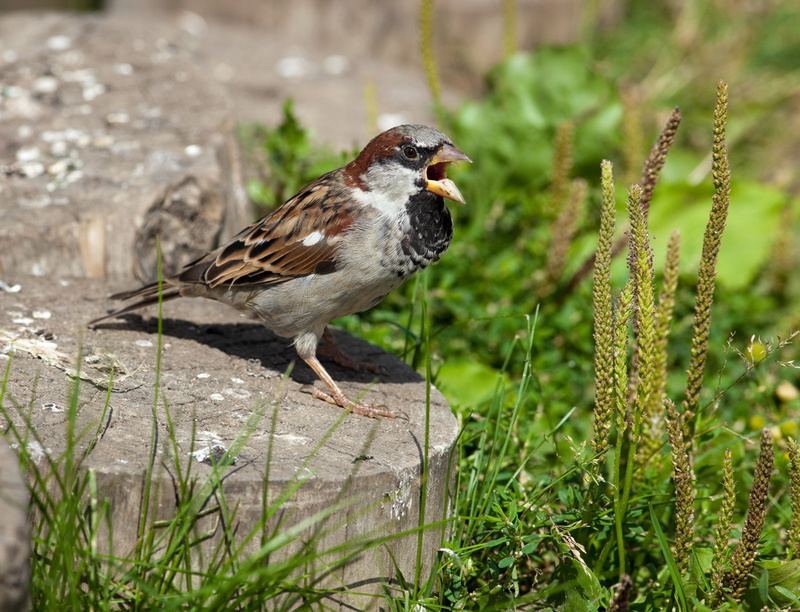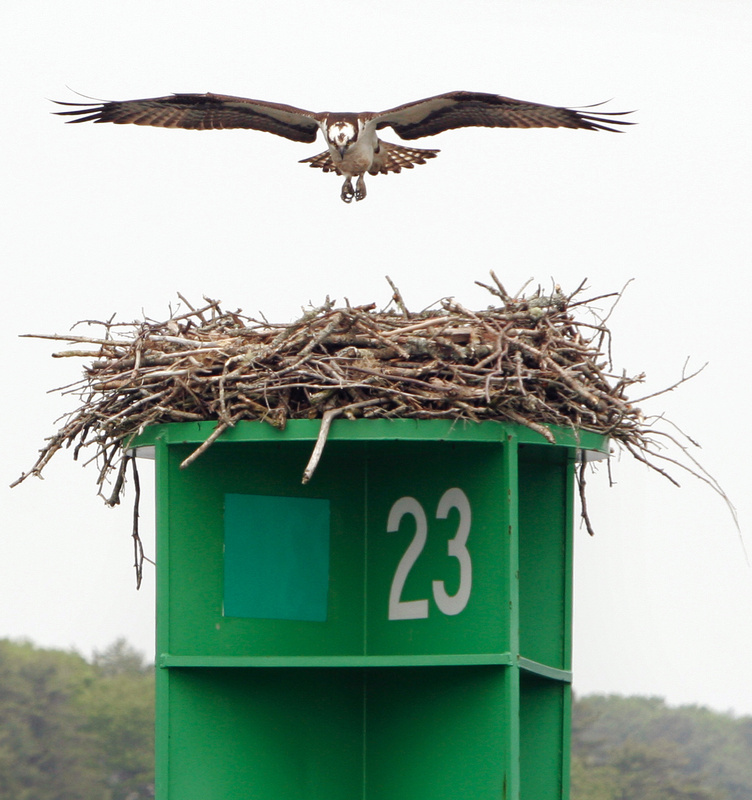The reproductive success of birds depends in large part on the location of the nest. A nest should provide protection from the elements. It also should be well hidden to prevent its discovery by egg or nestling predators.
Some bird species build their nests in the proximity of other species of birds. In today’s column, we will explore some of these nesting associations and learn the advantages of such arrangements.
This column was inspired by an observation that Bets Brown (my wife) made on June 16. Bets was conducting a breeding bird survey and I came along as her data recorder. At a stop in Monmouth, a pair of ospreys had constructed a nest atop an electrical transformer tower. Bets saw a couple of small birds disappearing into and emerging from the bottom of the massive nest. Those birds were house sparrows. What better place to put a nest?
Potential predators of house sparrow eggs or nestlings are likely to be deterred by the fearsome ospreys. As strict fish-eaters, ospreys pose little threat to the house sparrows.
A search of the literature revealed that house sparrows have been reported nesting in osprey nests in other areas.
Monk parakeets, which build spherical stick nests, have also been seen using osprey nests as a site for their own nest construction.
Although the pair of house sparrows we saw likely benefited from the association with ospreys, we do not know if the house sparrows particularly sought out the ospreys or simply found the massive nests of the ospreys to be a nice place to set up house. I suspect it was the latter.
In any case, house sparrows outnumber ospreys by many orders of magnitude, so a house sparrow nest in an osprey nest must be an exceptional event from the point of view of house sparrows.
However, nearly 100 bird species clearly prefer to nest in proximity to a more aggressive species.
Most examples of protected associates are waterfowl, shorebirds and songbirds, while the aggressive species sought out by the protected species are usually particularly aggressive shorebirds, falcons and sometimes stinging or biting insects.
In Ontario, yellow warblers prefer to nest close to gray catbird or red-winged blackbird nests. Near gray catbirds, predation on the warbler nests is significantly reduced. Brood parasitism by brown-headed cowbirds is greatly reduced in warbler nests near red-winged blackbird nests. The redwings aggressively keep cowbird females out of their territories.
On Kent Island in the Bay of Fundy, Savannah sparrows have two major nest predators: abundant but ineffective herring gulls and uncommon but ruthlessly effective American crows.
The sparrows choose to nest near the gulls because the gulls keep the crows away. The sparrows build their nests in dense microhabitats that the gulls avoid.
In the Siberian Arctic, more than 80 percent of red-breasted geese nest close to either peregrine falcon or snowy owl nests. Arctic foxes are a major threat to goose eggs and goslings.
In 454 hours of observations, no nest predation by foxes was observed for nests in the vicinity of owls or falcons. In fact, foxes only came within the defense area of the aggressive species twice and in both cases were quickly attacked.
The foxes fled with their tails literally between their legs.
In the Manitoba Arctic, long-tailed ducks choose to nest near arctic tern nests. In some habitats, the ducks place their nests within 3 meters of the aggressive terns.
We know at least one example where a protected associate has a negative influence on the aggressive species.
In Peru, black skimmers and two species of terns nest on beaches along the Manu River. The terns and skimmers actively defend their nests against predators. Sand-colored nighthawks nest among the skimmers and terns, often in numbers exceeding the aggressive species. The nighthawks never defend their nests, relying instead on the protection of the skimmers and terns.
The nighthawks had greater nesting success in association with the other birds. However, their presence reduced the success of the terns and the skimmers because they spent more time in defense and less in parental care.
The nighthawks are essentially parasitizing the terns and skimmers.
PURPLE FINCH PROJECT
Sarah Knutie, a graduate student at the University of Utah, is beginning a long-term monitoring project of purple finches. She is soliciting volunteers willing to keep track of purple finch, house finch and pine siskin abundance at their feeders from September through March.
The time commitment is modest, only one or two hours a month.
If you would like to help Knutie with her project, let her know of your interest by e-mailing her at purple.finches@gmail.com.
Herb Wilson teaches ornithology and other biology courses at Colby College. He welcomes reader comments and questions at
whwilson@colby.edu
Shutterstock (top)/
Staff file photo (below)
Send questions/comments to the editors.




Success. Please wait for the page to reload. If the page does not reload within 5 seconds, please refresh the page.
Enter your email and password to access comments.
Hi, to comment on stories you must . This profile is in addition to your subscription and website login.
Already have a commenting profile? .
Invalid username/password.
Please check your email to confirm and complete your registration.
Only subscribers are eligible to post comments. Please subscribe or login first for digital access. Here’s why.
Use the form below to reset your password. When you've submitted your account email, we will send an email with a reset code.